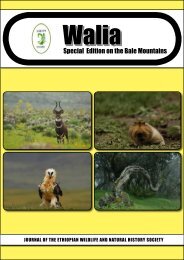Biodiversity of Mahale Mountains National Park, Tanzania | Report ...
Biodiversity of Mahale Mountains National Park, Tanzania | Report ...
Biodiversity of Mahale Mountains National Park, Tanzania | Report ...
Create successful ePaper yourself
Turn your PDF publications into a flip-book with our unique Google optimized e-Paper software.
<strong>Biodiversity</strong> <strong>of</strong> <strong>Mahale</strong> <strong>Mountains</strong> <strong>National</strong> <strong>Park</strong><br />
Figure 1<br />
Bird species accumulation curve for three sites in <strong>Mahale</strong> <strong>Mountains</strong> <strong>National</strong> <strong>Park</strong>.<br />
Total species recorded during sampling at Kasoge = 72; Kabezi = 103; and Mfitwa = 77.<br />
120<br />
100<br />
80<br />
60<br />
40<br />
20<br />
0<br />
Kasoge<br />
Kabezi<br />
Mfitwa<br />
0 1 2 3 4 5 6 7 8 9 10 11<br />
Days Recording<br />
The bird species assemblages at Kasoge and Kabezi were more similar to each other than<br />
either was to Mfitwa (Figure 2). However, the picture <strong>of</strong> the relationship between these three<br />
sites is somewhat incomplete because the species accumulation rate for Kasoge had not<br />
levelled <strong>of</strong>f by the end <strong>of</strong> the sampling period (Figure 1). An apparent increase in<br />
accumulation rate at Kabezi near the end <strong>of</strong> the survey period was due to several transects<br />
extending into montane habitat. New species were from that community but very few new<br />
Miombo and riverine forest species typical <strong>of</strong> the Kabezi site were added.<br />
4.2.1 Point Counts<br />
Two hundred and eighteen point counts <strong>of</strong> birds were made at three field sites in <strong>Mahale</strong>.<br />
Total counting time was 18.2 hours, during which 2643 individuals <strong>of</strong> 135 species were<br />
recorded (Appendix V, Table 5). Species accumulation curves suggest that sampling was<br />
incomplete for both Kasoge and Kabezi but had begun to level <strong>of</strong>f at Mfitwa (Figure 1).<br />
Kabezi had the highest abundance <strong>of</strong> birds at 164.5 per hour <strong>of</strong> sampling. Mfitwa and<br />
Kasoge had similar abundances with 120.7 and 118.5 birds per hour <strong>of</strong> sampling. The<br />
number <strong>of</strong> contacts (record <strong>of</strong> a species during sampling) was also higher at Kabezi with 90<br />
per hour, followed by Mfitwa with 78.9 per hour and Kasoge with 54.8 per hour.<br />
The only species to make the top ten list for all three sites and both categories was Yellowwhiskered<br />
Greenbul, Andropadus latirostris (Table 5). Common Bulbul was the most<br />
frequently encountered species and was recorded at 61.3% <strong>of</strong> sample points at Kabezi. It<br />
was also the most abundant species at both Kabezi and Mfitwa. The overall most abundant<br />
species was the migratory Eurasian Bee-eater, Merops apiaster, at Kasoge with more than 40<br />
birds counted per hour.<br />
Wildlife Conservation Society 12
















